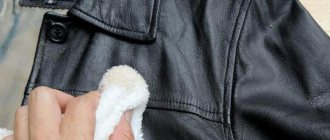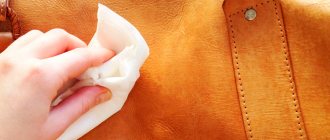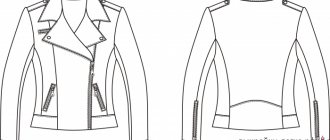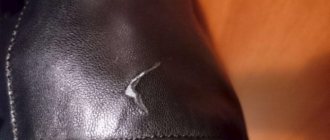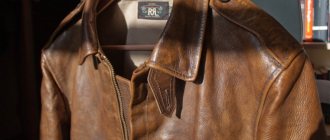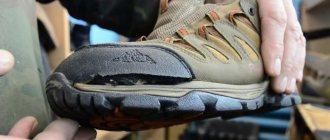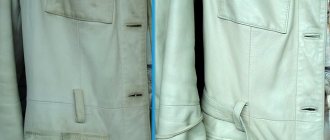It is no coincidence that leather products are popular. They have a stylish appearance, but require constant care. Sometimes in the lives of owners of leather goods such a nuisance occurs when a beloved item receives serious damage.
You can help restore it to its previous appearance only by knowing how to repair a leather jacket at home. Although there is an easier option - using the services of a clothing repair shop, not everyone can afford it.
And if we are talking about a simple defect, then you can eliminate it without difficulty and on your own. To do this, you will need to set aside some time and strictly follow the recommendations below. So, by saving a certain amount of money, you will give the product a second life.
How to avoid damaging a genuine leather jacket during repairs
Failure to comply with the repair technique causes new defects. To avoid them, you should:
- use only special adhesives;
- degrease the area being repaired;
- Make patches only from leather or thick textiles.
During repairs, it is strictly not recommended to use a hair dryer, hot iron or lighter.
By trying to speed up the cure of the glue, you are more likely to burn the fabric. Leather patches are used to disguise holes in visible places. If you don't have a sewing machine, don't try to sew on a chevron by hand. If the distance between stitches is not maintained, the work will not look neat.
Sealing
To seal the skin, you will need the following products:
- glue;
- leather material for backing and patch;
- scotch.
For gluing it is recommended to use Moment glue. It has good plasticity after complete drying. If part of the skin is torn out at an angle, the patch material remains in place. If the piece is completely torn out, it is necessary to use a leather piece, which has a similar texture and thickness. Its size should match the hole on the jacket. There are 2 sealing methods used:
- For a corner tear, use tape and patch it from the inside out.
- When a hole is formed, the hole is sutured from the inside and sealed with a patch from the front.
Return to contents
Wash
Leather products do not withstand high temperatures and various detergents, so washing them in a machine is strictly prohibited. This can be done exclusively by hand using gentle emulsions for cleaning leather products.
A good jacket made of genuine leather will serve its owner for a very long time if you take care of it and update it on time. Dyeing with special dyes, which you can do yourself at home, will help return clothes to their original presentable appearance.
This operation can be performed in two ways:
- use an aerosol can;
- Apply water-soluble powder.
Updating a leather jacket at home using the first method is very simple. To do this, you need to buy a can of spray paint in a specialized store or market. The color does not have to match the original. By choosing a different shade, the housewife will receive a new item that will enrich and diversify her wardrobe.
The amount of paint should be taken based on the manufacturer's recommendations. Usually the can indicates how much area can be covered with its contents. For a regular medium-sized jacket you need to take at least two units of dye. And for a coat you will need at least 2 times more.
Before applying paint, clothes should be cleaned with a damp sponge. After the skin has dried, the clothes are hung on hangers so that they hang freely without touching anything. To protect your hands, you should wear cellophane or rag gloves, and cover everything around with newspaper. The spray radius of the aerosol is quite large, so there is a risk of smearing paint on things and furniture.
The aerosol is applied from a distance of 20 cm evenly over the entire surface of the skin. Drying time is from an hour to two, the manufacturer indicates it on the packaging.
Painting with powder dye is somewhat simpler. After preparing the paint (according to the manufacturer’s recipe) in boiling water, cool it to +45°C. Do not do this again, it will ruin the jacket. The skin will become brittle and may tear quickly. Clothes are immersed in the solution for 2-3 hours, after which they are thoroughly rinsed so that the water becomes clean. Then the leather jacket is hung on hangers and allowed to dry thoroughly in a dark, ventilated room.
Experienced housewives advise placing clothes in the dye solution so that they do not twist or bend. This will allow the paint to cover everything evenly. Otherwise, there will be unpainted areas and the operation will have to be repeated.
The leatherette on the sofa is cracked, what should I do?
The upholstery on the sofa is exposed to mechanical stress almost constantly, especially if there are small children in the house. You don’t always want to get rid of a cozy leather sofa if it has cracks and damage. There are several options to get rid of this problem:
Repair kits, adhesive materials
This method is also suitable for small scratches that must be restored without fail. Today on the construction market you can purchase various replacement repair kits. It includes liquid leather and specialized tools to make it easier to apply. The assortment includes popular colors, so choosing them will not be difficult.
Adhesive materials require painstaking care and attention. Before starting work, be sure to read the instructions for using the product.
Disguise
Cracked areas can be masked using liquid polymer. It is based on alcohol, which helps the solution penetrate the top layer of the skin. This allows you to create a masking effect; the composition dries within 15 minutes. To apply you will need a piece of gauze and a spatula with which to apply the product. After drying, the skin and the composition become almost one whole, and the damage becomes almost invisible.
Partial replacement
This method is used in extreme cases when scratches cannot be repaired minorly. It can only be performed by a specialist who understands the technology. If there is multiple damage, it is better to use reupholstery of the sofa, since partial repairs will no longer save the product from the final loss of appearance and characteristics.
Eliminating holes
Every owner of such a thing should know how to fix a hole in a leather jacket.
After all, you need to act in this situation immediately. If restoration measures are not taken in time, then your favorite item can be damaged even more, and its appearance will be forever ruined.
On a note! Please note that once you have discovered the torn area, you should fasten it with adhesive tape from the wrong side.
This will prevent further spreading of the material. This is especially true if you are away from home and the time and resources do not allow you to begin repairs. Let's look at options for solving the most common problems and situations in which they are best used.
- Sew it up. This method is quite radical, but if the hole is quite large, then you simply cannot do without it. It will be problematic to glue a torn area of leather, so it is better to prepare threads, a suitable patch and a machine. So, now let's look at how to repair a leather jacket at home. First, you need to rip the lining, first turning the product inside out. Then carefully trim the edges of the hole to make it easier to pick up the patch and to make the damaged area look neat after repair. It is also very important to choose a material of the desired texture and appropriate color as a patch. If you do everything correctly, the jacket will look like new, and the place where the hole was will be completely invisible. You will need two patches: one can be made of any material, since it is attached from the inside, and the second - exclusively from leather that matches the jacket, because we will sew it on the outside. By the way, their size should be 1-2 cm larger than the incision site on all sides. Attach the selected scraps and sew them. Experts recommend choosing a strong needle for this procedure, which is designed for working with leather items. If you neglect this advice, you may not only ruin your jacket, but also damage your sewing machine.
- We seal it. Is it possible to repair a leather jacket without resorting to such radical methods? If you don’t have a sewing machine or the hole is small, you can carefully seal it. Place the torn piece in the damaged area using tweezers, and then glue it with tape. Next, you need to turn the jacket inside out and rip the lining to get to the hole on the inside. In this case, the prepared patch is glued to a piece of leather that we secured earlier. Once you have completed all the steps above, turn the product inside out and remove the tape. Make sure that the patch lies evenly, straighten it with your fingers and press firmly for 1-2 minutes. Let the glue dry completely and then sew the lining closed. Thanks to this method, you can quickly and efficiently repair your favorite item without resorting to the expensive services of specialists.
Basic methods of repair at home
The skin is sutured, sealed, and a patch is applied. Also, damage is hidden with a coloring spray.
What and how to seal a hole
Minor damage can be sealed with special glue. It is applied to the front and back sides for strength. This is the easiest and fastest way to repair a jacket.
Moment
Superglue is not suitable for repairing leather items as it contains cyanoacrylate. The substance hardens when it dries, and the canvas loses its elasticity. It is better to use the regular Moment 1 Classic. The moisture-resistant and heat-resistant product does not affect the plasticity of the product. The glue is produced in tubes of 30 milliliters. A small volume is enough to repair a jacket.
To glue a part with Moment, you need to press it firmly, and then put a press on top. Unlike superglue, when using Moment, it does not matter how many minutes you hold the part for gluing. The oppression will help keep it straight and without wrinkles.
See also
How to hang tulle beautifully, tips and types of hooks
Double-sided tape
How to repair a minor abrasion or tear:
- prepare a patch;
- secure the edges of the tear on the outside with transparent tape;
- place the product face down on the table;
- cut a piece of double-sided tape with a diameter 1-1.5 centimeters larger than the patch;
- stick a patch on one side of the tape so that there are free centimeters at the edges;
- Apply the other side of the tape to the wrong side of the tear.
Using double-sided tape, you can seal the cut with any piece of fabric. The renovated space will remain flexible. If the tear is noticeable from the outside, it should be touched up.
We remove the hole using a decorative seam
In order not to bother with glue and selecting patches, you can sew up a torn jacket. There are two ways to tidy up your product:
- sew a straight, even cut with thread along the front side;
- Place a thin strip of leather over the torn edges, and also sheathe the top.
A regular “cross” is suitable for decoration. A more complex but dense goat stitch looks bright if you embroider it with threads of two colors. A decorative trim strip can be used to beautifully cover torn leather near pockets.
How to mend a gap
A large hole with a completely torn out piece of leather is covered with a patch from the outside and from the inside, under the lining. Repair method:
- tear off the lining along the factory seam;
- glue the backing on the inside and wait until it dries;
- cut out a piece of leather or substitute that follows the contours of the hole;
- insert into the hole on the front side so that the edges of the patch coincide with the edges of the hole;
- Fill the gaps between the insert and the edges of the gap with glue;
- When the outer patch is dry, sew on the lining.
If the outer workpiece is different in color, it can be painted with cream or spray dye.
The gap, closed with a piece of leather of the same color as the jacket, must be lubricated with a softening cream so that the product does not become brittle from the hardened glue.
How to seal a cut
When cutting, one backing is enough. Repair method:
- open the cut from the inside out;
- bring the edges together and seal the outside with tape;
- stick a patch on the inside;
- hold it under a load;
- After the substrate has dried, peel off the tape;
- Use a toothpick to apply glue between the edges of the cut.
Once dry, the damage will be almost invisible. You can completely hide the cut using a coloring spray.
What to do if part of the material is torn off
How to repair a torn corner tear:
- put the torn piece back in place and seal it with tape;
- turn the jacket inside out;
- tear off the lining on the torn part of the product;
- degrease the gap from the face and back;
- stick a patch on the back side of the tear;
- peel off the tape and sew on the lining.
See also
11 best ways to quickly stretch jeans at home
After careful repair, the tear site is almost invisible.
Repairing collar and cuffs step by step
Methods for restoring various damage to the collar:
- scratches, abrasions - paint over with spray or cream;
- torn holes - apply patches;
- torn collar - sew the tear on top with a decorative stitch or sew from the inside out.
You can change frayed cuffs yourself:
- turn the sleeve inside out, tear off the lining and the damaged part;
- cut the same one from a suitable material;
- sew by hand.
The edges of the cuffs worn to white will be hidden by a edging made of thin leather or its substitute sewn on top.
Application of liquid skin
Cuts and abrasions can be easily removed using a special solution. In stores selling sewing supplies and accessories you can choose the desired shade. Liquid leather of different colors is also mixed to obtain a color close to the original. Before applying the product, the surface must be degreased. Using liquid skin, damage of varying complexity is removed:
- Small scratches are covered with a thin layer, without going beyond the boundaries of the damage. Excess product is blotted with a sponge;
- a patch is glued under through gusts, and liquid leather is applied on top of it on the front side in 2-3 layers. If the edges of the tear are uneven, they are trimmed with a blade.
The solution is prepared according to the instructions indicated on the package. How to process the product:
- Apply a slightly larger piece of bandage to the damaged area;
- Apply the first layer of liquid leather using a plastic spoon or spatula;
- After drying, apply a second layer.
Liquid skin dries in 3-4 hours. A large area covered in several layers will take up to 8 hours to dry. You need to prepare as much solution as is needed for one layer.
How to reduce in size with your own hands
Leather items stretch over time. Basic knowledge of a cutting and sewing course will help you sew a jacket at the shoulders or waist. Work plan:
- take measurements;
- tear off the lining;
- open the seams;
- outline new parameters;
- sweep by hand and try on;
- Sew the seams according to the marks.
When removing extra centimeters from the waist, it is important to ensure that the jacket does not sit too loosely on the chest. If the top looks baggy, you will have to cut out the darts yourself.
What cosmetic products are needed for renewal?
A new leather jacket is treated with a special protective layer that prevents it from getting wet. The surface of the product will have a beautiful shine as long as the protection maintains its integrity.
With active wear, abrasions form in areas exposed to active friction, where the paint begins to peel off and bald spots appear.
If after purchasing the jacket you regularly treat it with leather care products, the protective layer will remain and there will be no abrasions.
With active wear, abrasions form in areas exposed to active friction, where the paint begins to peel off and bald spots appear.
This allows you to determine what type of leather was used to sew it and study recommendations for its care. Then you should visit a specialized household chemicals store and select products that will help keep the jacket in good condition. To care for natural leather, you often purchase:
- spray paint for nubuck and suede;
- colorless wax for rough smooth skin;
- cream paint with a shine effect for smooth skin;
- colorless cream paint for colored jackets;
- glycerin to soften rough surfaces;
- water-repellent impregnation;
- a product for restoring heavily worn areas.
All these tools allow you to solve the problem of how to update a leather jacket at home. Protective cosmetics are used every time the jacket gets wet and dried. Active use of outerwear requires additional updating of the surface layer using water-repellent impregnation once every 10 days.
Protective cosmetics are used every time the jacket gets wet and dried
Where to go if you have a jacket and a sofa?
Leather jackets are repaired in specialized workshops. There are professionals working there who select the best option for eliminating damage to the product.
Contact any clothing restoration shop.
In the case of a sofa, you need to contact a company that specializes in furniture restoration, reupholstery and assembly. Usually the process does not take much time, and specialists can work at the client’s home.
Each item requires careful care and attention, especially when it comes to leather versions of the product. A leatherette jacket should only be stored on hangers, and it should be cared for by dry cleaning. It is better to cover a sofa made of this material with a special cover that protects the product from damage. Take good care of your things and they will last you a long time.
Bringing back the shine
The last step in restoring a jacket is bringing back the shine. If you are planning to apply it at home, you can safely proceed. The procedures are simple, anyone can do them.
To restore the shine to the jacket, you need to take 2 egg whites, shake and apply to the surface with a sponge.
Ground coffee will make your skin glow. This method is used only for dark material. The coffee grounds are collected in a woolen or flannel cloth and rubbed on the leather surface.
Another way is to rub clothes with laundry soap dissolved in warm water with the addition of a few drops of glycerin.
Castor oil also has a rejuvenating effect. First, the item is cleaned from dust with soapy water or ammonia. Then the sponge is soaked in castor oil and the entire product is rubbed.
Repairing the collar
If there are loose areas of skin, they need to be cut off. Repairing the collar is complicated by the large amount of dirt that accumulates on this part of the jacket. To clean dirt, you should wipe the collar with gasoline (preferably aviation gasoline). To completely remove dirt, the procedure is repeated at least 2 times. Then the collar is cleaned of gasoline residues with a sponge and soap solution.
Since it is inconvenient to place a patch on the collar, paint is applied to the damaged areas. It is advisable to do this with a sponge. To ensure that the paint sticks, it is recommended to apply varnish on top. If you don’t have a special one, you can use a transparent manicure.
Restore the elasticity of a leather jacket
It is always worth remembering that the skin should be soft and elastic, this is its normal condition. You can prevent the appearance of cracks by maintaining the elasticity of the skin. To do this, use the following tools:
- Castor oil. Mix 50 ml of oil and egg yolk until smooth. Wipe your jacket with this mixture.
- Laundry soap. Half a bar of laundry soap should be dissolved in a liter of hot water. Add five grams of fish oil and forty grams of ammonia to the resulting solution. Treat the jacket with the resulting product.
- Butter. The elasticity of the jacket can be restored by using butter. To do this, dissolve the oil in warm water (3 liters 70 grams). Add ammonia to the mixture in a ratio of 3:1.
- Ammonia or acetone. Wipe the product with acetone (ammonia), then also thoroughly treat it with glycerin.
How to restore the color of a leather jacket
Wearing a jacket for a long time causes it to fray on the cuffs, collar and elbows. The color becomes uneven and the item looks unattractive. But it doesn’t matter, the leather can be dyed and the clothes will look like new. To do this, you can use paint in the form of an aerosol or powder, choosing the appropriate shade.
How to treat a leather jacket with a powder composition? Follow this procedure:
- Dilute the paint with water according to the instructions. Make sure that there are no lumps left in the composition.
- Strain the solution to refresh the color and place the jacket in it for the time specified in the instructions.
- Then wring out and rinse the product thoroughly.
- Treat the skin with a solution of a liter of water, a glass of 3% vinegar and 2 teaspoons of salt. This will help set the dye.
- Send the processed product to dry.
Remember that leather items should only be hung on hangers, including for drying.
How to restore color using spray paint and remove scuffs? Do the following:
- Wipe the item with a damp cloth.
- Hang it on hangers, straightening out the folds and creases.
- Spray the aerosol, holding the can at a distance of 20 cm from clothing.
If you notice any drips while painting, wipe them off immediately with a foam sponge. After treatment, the jacket must dry for at least an hour.
Additional tips and tricks
The following rules will help you repair your favorite jacket:
- use non-marking tape;
- To check the quality of the tape, you need to glue a piece to a sample of leather. If a sticky trace remains, you can loosen the adhesiveness of the tape - stick it on and off several times;
- instead of Moment, you can use any moisture-resistant elastic adhesive - polyurethane Desmokol, chloroprene SAR30E Kenda Farben;
- work quickly, before repairing, remember the instructions or check point by point with the note on a piece of paper;
- cut the patch 1 centimeter larger than the size of the tear;
- do not keep the patch coated with glue suspended for a long time, otherwise it will dry out and it will be impossible to correct its position after gluing;
- the surface to be treated must be dry;
- Instead of a leather patch, you can use a fabric patch, but the fabric does not adhere to the skin well;
- the leather insert can be painted with leather cream, but it is less durable than paint;
- apply the patch evenly, otherwise folds will form;
- To make the patch fit better, after gluing it you need to lightly tap it with a hammer;
- It is not necessary to rip off the lining; you can cut the fabric under the tear and then sew it up.
If you couldn’t match the patch by color, you can glue a contrasting piece, and a few more of the same ones for decoration.
Share link:
- 03.01.2017
If you bought high quality leather items, they are usually quite resistant to wear. Of course, subject to certain rules for caring for such material. It happens that the skin (especially on the jacket) literally begins to “crumple.” Often this indicates that the material is not of high quality or, alas, in front of you in general - leatherette. What to do if the material literally “crumbs” before your eyes?
To restore or not - that is the question
If you are dealing with leatherette, then in most cases there is no point in doing restoration. Even if the master manages to fix the problem - most likely, not for long - and after a while the material will again look bad.
If the jacket is really made of high quality leather and begins to “crumble” after long wear, you can try to save it. The problem can be eliminated by using special “liquid skin”-type compounds that can restore the structure of the material. Important: if you plan to use the product, test it on a piece of paper, which you don’t mind throwing away if something happens. Do not use untested formulations or products not intended for use on the skin.
How to avoid problems in the future
The best way to deal with such problems is, of course, timely prevention. If abrasions appear on the product, they should be eliminated as soon as possible so that the defect does not become more complicated. To do this, you can use a special paint for leather AM Coatings. And in the future, follow these simple recommendations that will help you preserve your belongings:
— Timely and thoroughly clean things from dirt, especially at seams
— It is better to remove simple stains using a swab dipped in soapy water or warm water
— It is strictly forbidden to get leather items too wet
- Products can only be dried at room temperature
And one more important point. If you cannot cope with the defect yourself (or it is too complex), it is better to seek the help of specialists who know how to correct the situation.
Common Mistakes
How can you ruin the appearance of a jacket:
- seal the gap with PVA glue - the patch, held on by a water-soluble compound, will fall off after rain;
- sew on a machine with a thin needle - to work with leather in the studio they use a special machine and needles;
- overuse glue - marks will remain on the front side;
- To paint a patch without testing - you need to try on a small whole area of skin to see how the paint or cream will look.
Leather stitched on a regular sewing machine stretches and wrinkles. Dried excess glue can be wiped off with a dry cloth. You cannot wash off traces with water, as the moisture will cause the patch to come off.
Features of working with leatherette
Artificial leather, like natural leather, is repaired using patches. But it is important to choose the appropriate adhesive for the material. Chemicals can damage the leatherette fibers and ruin the item. Adhesive for skin substitutes is available in aerosol form. A universal product suitable for eco-leather containing natural fibers. It is applied in a thin layer, so the product retains its elasticity.
See also
How to fold bags compactly and correctly, life hacks and storage ideas

